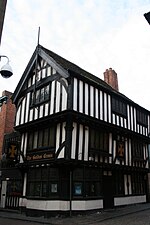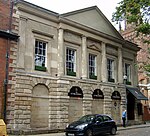Kirby House, Coventry
Buildings and structures in CoventryGrade II* listed buildings in the West Midlands (county)Grade II* listed housesUse British English from December 2016West Midlands (county) building and structure stubs

16 Little Park Street (also known as Kirby House) is a Georgian townhouse (Grade II* listed) in central Coventry, West Midlands, England. It is one of two remaining Georgian buildings on the street and three in the city centre (the other two being 7 Little Park Street and 11 Priory Row). The name Kirby House comes from Thomas Hulston Kirby who bought it in 1874.As of 2021, the building is occupied by the Citizens Advice Bureau.
Excerpt from the Wikipedia article Kirby House, Coventry (License: CC BY-SA 3.0, Authors, Images).Kirby House, Coventry
Little Park Street, Coventry Hillfields
Geographical coordinates (GPS) Address External links Nearby Places Show on map
Geographical coordinates (GPS)
| Latitude | Longitude |
|---|---|
| N 52.40615 ° | E -1.5088 ° |
Address
Little Park Street 16
CV1 2JZ Coventry, Hillfields
England, United Kingdom
Open on Google Maps










